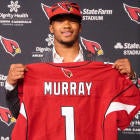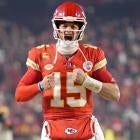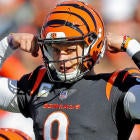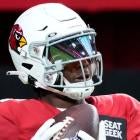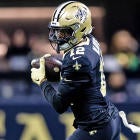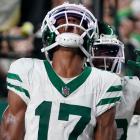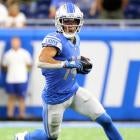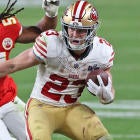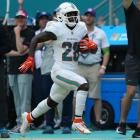Welcome to our 2019 Player Profiles series. We are going through the top-150 in Heath Cummings, Jamey Eisenberg and Dave Richard's consensus PPR rankings to give you the case for and the case against drafting each player. By the time you're done, you'll know everything you need to know for drafting in 2019.
Here are players 140-131, featuring a couple high-upside rookies and some vets we're hoping to see bounce back:
140. Mohamed Sanu, WR, ATL
The Case For: As bench receivers go, Sanu is among the safest. He's finished among the top-30 receivers regardless of format each of the last two seasons. He also figures to never see more than average coverage since he shares the field with Julio Jones and Calvin Ridley. He's also available super late in every single draft.
The Case Against: As bench receivers go, Sanu is among the lamest. Last year he hit 10-plus points in non-PPR (12 in PPR) six times and was at seven points or fewer (11 or less in PPR) 10 times. That's consistent with how he performed in 2017, making him a low-ceiling, low-floor receiver who will see targets flutter toward Jones and Ridley on a weekly basis. What's the point of taking a receiver who you may only use to cover bye weeks? You could just add him (or someone like him) off waivers when you're in need.
139. Alexander Mattison, RB, MIN
The Case For: Mattison's a pretty good running back in a potentially great situation. A strong, well-built runner with good hands, Mattison had back-to-back 1,300-total-yard campaigns at Boise State with 30 total touchdowns. He's a good fit with the Vikings' improved zone-run scheme, and it's pretty clear that any rusher behind Dalvin Cook on the depth chart has a chance to find some playing time during the year. He's a running back worth your patience. Take him in Round 10 whether you selected Cook earlier or not.
The Case Against: Speed isn't his specialty -- he needed a lot of volume in college to accumulate stats. That will most certainly be the case in 2019 as Mattison will only have use if Cook misses playing time. And it's been three years since a Vikings running back finished as a top-20 player in any format. What's that say about Mike Zimmer's desire to be run-focused? There's no qualm about Mattison hanging on the bench as a handcuff to Cook, but even without Cook, what good will this guy give you?
138. Kyler Murray, QB, ARI
The Case For: Murray shouldn't be viewed as your typical rookie quarterback. He's joining an offense he's already familiar with and a head coach he's known since high school. Several targets in the offense are former college teammates, and those he's not familiar with either have youthful legs or a Hall of Fame pedigree. And not only does Murray possess an accurate, powerful arm, but he will run plenty. Here's an idea: Draft Murray and another passer, both in Round 9 or later. Use the other passer until you're comfortable starting Murray. If anyone in the draft class has a chance to be the next Deshaun Watson, it's Murray.
The Case Against: Crowing about Murray's obvious inexperience at the pro level is low-hanging fruit. Let's check in with his offensive line, which returns three disappointing starters from their 2018 Week 1 unit along with a couple of mediocre veterans. Only one -- right tackle Marcus Gilbert -- received a positive grade from Pro Football Focus last season. Murray's receiving corps isn't as experienced in the Cardinals' new offense as he is, suggesting a learning curve there. His coaching staff is equally fresh-out-of-water. A lot will have to go right for Murray to be a no-doubt starter.
137. Chris Herndon, TE, NYJ
The Case For: Herndon figures to be a regular starter in the Jets' refreshed offense under play-caller Adam Gase. It helps that he's got a nice, young quarterback in Sam Darnold and an offense that should keep him in single coverage in every route he runs. Herndon's rookie numbers were a little underwhelming (39-503-4) but he flashed explosiveness with nine receptions of 20-plus yards and added a 75 percent catch rate on red-zone targets. Drafting him late as an early-season streamer is the easy part -- counting on him to show off what he can do in a suddenly crowded Jets offense is what would send his Fantasy stock into the stratosphere.
The Case Against: Darnold has more options on offense than he did last year. Le'Veon Bell is definitely going to get his cut of targets, as will slot speedster Jamison Crowder. That hurts Herndon, who saw four targets or fewer in 12 of 16 games last season. Herndon also has yet to show he's more than a touchdown-or-bust tight end, falling under 70 yards in 15 of 16 games. Adam Gase is supposed to be some kind of tight end developer, but in three years with the Dolphins he never squeezed more than 388 yards or four touchdowns out of one tight end. Shoot, his tight ends combined for 12 touchdowns over three years!
136. Robert Foster, WR, BUF
The Case For: Foster is the only receiver on the Bills with more than a year's worth of experience in Brian Daboll's offense (the two worked together at Alabama in 2017) and more than a handful of targets from Josh Allen. That combination blossomed toward the end of last season when Foster finished with 100 yards and/or a touchdown in five of his final seven matchups. Early reports from Buffalo suggest Foster's route running has improved and he's still got good chemistry with Allen. He's got a shot at popping off for some good games given the Bills' early season schedule (at the Jets, at the Giants, versus the Bengals).
The Case Against: Foster is the very definition of a boom-or-bust receiver who seemed to boom a little more often than bust last November and December. His game is predicated on his speed -- if he doesn't catch a long pass, he's often left with weak stats. And he didn't get many opportunities to boom when he was hot last year, averaging 5.0 targets per game in his final seven contests. As nice as it is that he's doing well in spring practices, the reality is that the Bills added John Brown and Cole Beasley this offseason, both of whom should help keep Foster's target share low. How can you trust a Bills receiver when there's so much more upside among many pass-catchers in the 2019 rookie class?
135. Vance McDonald, TE, PIT
The Case For: Last year's No. 12 tight end, McDonald returns to a Steelers offense in need of reliable options. Not only is Antonio Brown gone from the Steel City, but fellow tight end Jesse James has also moved on. That should open up chances for McDonald to improve on the 4.8 targets per game he had in 2018 (or the 2.9 targets per game he's averaged over his career). You could do worse with a late-round pick.
The Case Against: There will be injuries. McDonald has yet to play 16 games in a single season and played 11 or fewer games in two of his past three. We're also talking about a player who has posted games with 70-plus yards four times in six seasons. And it's not like the Steelers are left bare with receiving options, not to mention red-zone options. So in trusting McDonald, you have to hope he either scores a ton of touchdowns or sees an opportunity unlike he's ever had before -- and doesn't get nicked up in the process. He's not even an attractive streamer thanks to matchups against the Patriots and Seahawks to start the year.
134. Kareem Hunt, RB, CLE
The Case For: Here's a refresher in case you forgot: In 27 games, Hunt averaged 4.7 yards per carry and 10.5 yards per catch, nabbed 80.6 percent of his targets, had 19 plays of 20-plus yards and four plays of 40-plus yards, and scored 25 total touchdowns. That should be enough to qualify him as "good." When he comes back from his suspension in Week 10, he'll bring fresh legs with big potential to a Browns offense that figures to contend for a playoff spot.
The Case Against: Are you really about to draft someone who'll be a bench ornament for the first nine weeks of the Fantasy season? I get that you'd want someone like Hunt on your team for the playoff run, but picking him and holding him for the entire year is quite a commitment. Hunt is also promised nothing in terms of playing time once he comes back -- he might be a 10-touch a week guy behind Nick Chubb. The best plan is to let someone else draft Hunt, then you pick him up off waivers once he's dropped for a bye-week receiver in Week 5.
133. Nyheim Hines, RB, IND
The Case For: As a rookie with fluctuating playing time, Hines caught 63 passes. He also had 85 carries and totaled 739 yards from scrimmage with four touchdowns. Hines has the potential to carve out a role as the Colts' third-down back and offer contributions in the passing game. Thus, his value is especially good in PPR.
The Case Against: Hines had 10 or more touches in eight games, 15 or more touches in a game once. He had two double-digit Fantasy outings in non-PPR and five in full PPR. As the season went on, his playing time dropped because Marlon Mack was crushing it for the Colts. He has a better chance of becoming a special-teams contributor than an every-down running back. He's a low-upside Fantasy running back you'll develop little confidence in.
132. Jamison Crowder, WR, NYJ
The Case For: Turning just 26 in June, there's some post-hype breakout potential for Crowder a few years and a new team removed from when he was last a Fantasy darling. Not much is known about how Adam Gase's offense will look with the Jets, but while he was in Miami it was Jarvis Landry who most consistently posted viable production. Presumably, when the Jets gave Crowder $17 million guaranteed this offseason, it was because they thought he could be similarly productive out of the slot.
The Case Against: The Jets have a quietly strong stable of pass-catching weapons, with Le'Veon Bell among the league's best at running back, Robby Anderson and Quincy Enunwa a solid wide receiver pair, and Chris Herndon an emerging young tight end. That could make consistent targets tough to come by, and there's no guarantee those will be high-quality targets if Sam Darnold doesn't take a step forward in his second season, as many expect.
131. T.J. Hockenson, TE, DET
The Case For: Expectations for rookie tight ends are never very high, but Hockenson figures to be an every-down player for a Lions offense in need of assistance. The nearly 6-foot-5, 250-pounder moves like a gazelle and has excellent hands, providing a massive mismatch piece for Matthew Stafford to lean on. The No. 12 tight end in PPR over the last four years has finished with an average of 53 catches, 555 yards and 4.5 touchdowns. That's not much to ask from Hockenson, who begins the season with a nice matchup at the Cardinals. When you're taking a tight end late, why not go with a young one with lots of upside?
The Case Against: In the last decade of football, only three rookie tight ends have finished as top-12 options in non-PPR (only two in PPR). Usually rookie tight ends take a while to acclimate to the NFL game, so the odds are stacked against Hockenson. Plus he's on a team that'll run the ball plenty and has a bunch of other targets for Stafford to lean on. Stafford's never been a big tight-end targeter anyway. Sure, he can be had late, but so could plenty of other tight ends with a safer floor than Hockenson.













